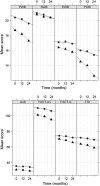Morbidity, mortality and quality of life in the ageing haemodialysis population: results from the ELDERLY study
- PMID: 27994865
- PMCID: PMC5162412
- DOI: 10.1093/ckj/sfw087
Morbidity, mortality and quality of life in the ageing haemodialysis population: results from the ELDERLY study
Erratum in
-
Erratum: Morbidity, mortality and quality of life in the ageing haemodialysis population: results from the ELDERLY study.Clin Kidney J. 2017 Feb;10(1):141-143. doi: 10.1093/ckj/sfw141. Epub 2017 Jan 25. Clin Kidney J. 2017. PMID: 28638615 Free PMC article.
Abstract
Background: The physical-functional and social-emotional health as well as survival of the elderly (≥75 years of age) haemodialysis patient is commonly thought to be poor. In a prospective, multicentre, non-interventional, observational study, the morbidity, mortality and quality of life (QoL) in this patient group were examined and compared with a younger cohort.
Methods: In 92 German dialysis centres, 2507 prevalent patients 19-98 years of age on haemodialysis for a median of 19.2 months were included in a drug monitoring study of darbepoetin alfa. To examine outcome and QoL parameters, 24 months of follow-up data in the age cohorts <75 and ≥75 years were analysed. Treatment parameters, adverse and intercurrent events, hospitalizations, morbidity and mortality were assessed. QoL was evaluated by means of the 47-item Functional Assessment of Chronic Illness Therapy-Anaemia score (FACT-An, version 4).
Results: The 2-year mortality rate was 34.7% for the older cohort and 15.8% for the younger cohort. The mortality rate for the haemodialysed elderly patients was 6.2% higher in absolute value compared with the age-matched background population. A powerful predictor of survival was the baseline FACT-An score and a close correlation with the 20-item anaemia subscale (AnS) was demonstrated. While the social QoL in the elderly patients was more stable than in the younger cohort (leading to equivalent values at the end of the study period), a pronounced deterioration of physical and functional status was observed. The median number of all-cause hospital days per patient-year was 12.3 for the elderly cohort and 8.9 for the younger patient population. The overall 24-month hospitalization rate was only marginally higher in the elderly cohort (34.0 versus 33.3%).
Conclusions: In this observational study, the mortality rate of elderly haemodialysis patients was not exceedingly high compared with the age-matched background population. Furthermore, the hospitalization rate was only slightly higher compared with the younger age group and the median yearly hospitalization time trended lower compared with registry data. The social well-being of elderly haemodialysis patients showed a less pronounced decline over time and was equal to the score of the younger cohort at the end of the study period. The physical and functional status in the elderly patients was lower and showed a sharper decline over time. The baseline FACT-An score correlated closely with the 24-month survival probability.
Keywords: chronic haemodialysis; elderly; quality of life; survival analysis; vascular access.
Figures




Similar articles
-
How much is enough? An investigation of the relationship between haemodialysis adequacy and quality of life of elderly patients.Nephrology (Carlton). 2016 Apr;21(4):314-20. doi: 10.1111/nep.12594. Nephrology (Carlton). 2016. PMID: 26369623
-
A study of the response of elderly patients with end-stage renal disease to epoetin alfa or beta.Drugs Aging. 2004;21(3):187-201. doi: 10.2165/00002512-200421030-00004. Drugs Aging. 2004. PMID: 14979736 Clinical Trial.
-
Predictors of quality of life and survival following Gamma Knife surgery for lung cancer brain metastases: a prospective study.J Neurosurg. 2018 Jul;129(1):71-83. doi: 10.3171/2017.2.JNS161659. Epub 2017 Aug 18. J Neurosurg. 2018. PMID: 28820304
-
Liberation from prolonged mechanical ventilation.Crit Care Clin. 2002 Jul;18(3):569-95. doi: 10.1016/s0749-0704(02)00016-7. Crit Care Clin. 2002. PMID: 12140914 Review.
-
A systematic review on the quality of life and functional status after abdominal aortic aneurysm repair in elderly patients with an average age older than 75 years.J Vasc Surg. 2019 Apr;69(4):1268-1281. doi: 10.1016/j.jvs.2018.09.032. Epub 2018 Dec 19. J Vasc Surg. 2019. PMID: 30578073
Cited by
-
The effects of megestrol acetate on nutrition, inflammation and quality of life in elderly haemodialysis patients.Int Urol Nephrol. 2019 Sep;51(9):1631-1638. doi: 10.1007/s11255-019-02245-8. Epub 2019 Jul 29. Int Urol Nephrol. 2019. PMID: 31359357 Clinical Trial.
-
Discontinuation of Hemodialysis After 8 Years in Favor of Toprak's Kidney Care in a Patient with End-Stage Kidney Disease.Am J Case Rep. 2021 Apr 25;22:e930857. doi: 10.12659/AJCR.930857. Am J Case Rep. 2021. PMID: 33895768 Free PMC article.
-
Impact of Adverse Drug Reactions in Patients with End Stage Renal Disease in Greece.Int J Environ Res Public Health. 2020 Dec 6;17(23):9101. doi: 10.3390/ijerph17239101. Int J Environ Res Public Health. 2020. PMID: 33291233 Free PMC article.
-
Risk factors for mortality in elderly haemodialysis patients: a systematic review and meta-analysis.BMC Nephrol. 2020 Aug 31;21(1):377. doi: 10.1186/s12882-020-02026-x. BMC Nephrol. 2020. PMID: 32867718 Free PMC article.
-
Association between early elevated phosphate and mortality among critically ill elderly patients: a retrospective cohort study.BMC Geriatr. 2022 Mar 15;22(1):208. doi: 10.1186/s12877-022-02920-z. BMC Geriatr. 2022. PMID: 35291970 Free PMC article.
References
-
- United States Renal Data System. USRDS 2011 Annual Data Report: Atlas of Chronic Kidney Disease and End-Stage Renal Disease in the United States. Bethesda, MD: National Institutes of Health, National Institute of Diabetes and Digestive and Kidney Diseases, 2011
-
- ERA-EDTA Registry. ERA-EDTA Registry Annual Report 2009. Amsterdam, The Netherlands: Academic Medical Center, Department of Medical Informatics, 2011
-
- ANZDATA Registry. ANZDATA Registry Report 2010. Adelaide, South Australia: Australia and New Zealand Dialysis and Transplant Registry, 2011
-
- Kurella M, Covinsky KE, Collins AJ et al. . Octogenarians and nonagenarians starting dialysis in the United States. Ann Intern Med 2007; 146: 177–183 - PubMed
-
- De Nicola L, Minutolo R, Chiodini P et al. . The effect of increasing age on the prognosis of non-dialysis patients with chronic kidney disease receiving stable nephrology care. Kidney Int 2012; 82: 482–488 - PubMed
LinkOut - more resources
Full Text Sources
Other Literature Sources

